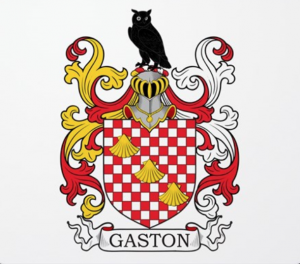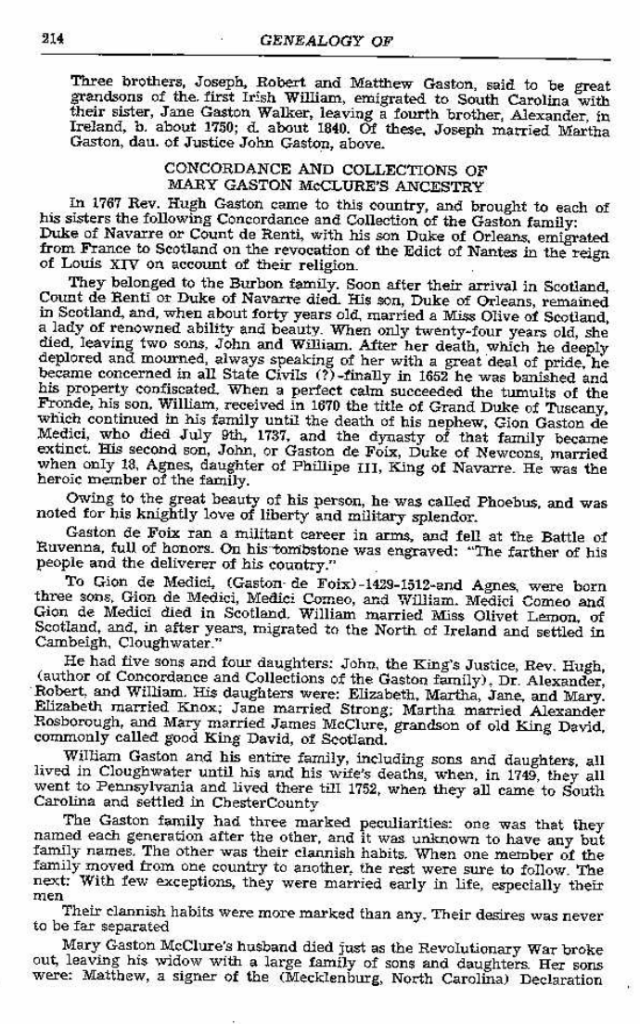
Jean Gaston- French Huguenot Refugee-
Jean Gaston, the Huguenot. This Jean was banished from France by the Catholics and fled to Calvinist Scotland about the middle of the seventeenth century. His property was confiscated but his brothers and relatives who remained Catholics in France sent means to Scotland for his living. One anecdote concerning this founder of the Protestant branch of the family was brought by his descendants to South Carolina: Jean Gaston was a devout man and the worst words he was ever heard to say were on the occasion of his hurting his mouth with a fork, an implement just coming into table use. Jean Gaston exclaimed “Devil take the fork!” And his Calvinistic progeny remembered it for one hundred years.
The sons of Jean Gaston emigrated from Scotland to County Antrim, Ireland, probably during the 1660’s, a time of religious persecution in Scotland. Which of the sons was the ancestor of the South Carolina Gastons is not known but John Gaston appears on the hearth-money rate list for Ireland in 1669 as of Magheragall, County Antrim. It is certain that William Gaston, grandson of the Huguenot Jean, lived at Clough Water, County Antrim (near Ballymena) Ireland, and was the father of the first of the name in Carolina. From the neighborhood of Ballymena, also, came the brothers John and Alexander Gaston, ancestors respectively of the Massachusetts and western states Gastons.”
Early Irish Gastons
Genealogist Charles Hanna, in his landmark “Ohio Valley Genealogies” (1900) listed among probable ancestors of the US Gastons a “John Gaston” who appeared on the Hearth Money Rolls of County Antrim, Northern Ireland, in 1669.
However, succeeding generations have found not just one, but several Gaston — or “probable” Gaston — households throughout Antrim during this period. They are listed on the following table, and the list is still incomplete as new Gastons keep turning up. Spelling variations are easily explained by the fact that many of the householders on these rolls were likely illiterate; the name was spelled by the tax collector as pronounced by the taxee. Given the local and regional speech variations common in Ireland, it would hardly be surprising if “Gaston,” “Gelstone” and “Gestan,” for example, all reflected regional pronunciations of the same name.
True to its name, the Hearth Money tax was based on the number of fireplaces in the home, and the feared collector was known as the “Smoke Man.” The tax was imposed only on householders, indicating that all Gastons listed on the attached table were heads of families, or at least had established their own homes. Of particular interest to US and Canadian Gastons is the “mid-Antrim” group clustered around Ballymena, and encompassing John, Robert, William and the “Widow” Gaston. All of these male names were in common use among the early North American Gastons.
Further, William Gaston and “Widow Gaston” of Killagan parish lived in or around Clough Mills, near to which is Carnlea and through which runs the Cloughmills Water. It is interesting to compare this William with the reputed founder of the Southern Branch of American Gastons, who has come down to us as “William Gaston of Caranleigh, Cloughwater.” According to tradition, this “William of Caranleigh’s” children began migrating to South Carolina in the 1740s.
While 1669 William of Killagan is too old to have been “William of Caranleigh” — who was still alive in the 1770s — it’s still the right name in roughly the right location. The existence of a documented William Gaston, living on or near the Cloughmills Water, thus supports tradition that the American Gastons originated in the Ballymena area, while giving rise to speculation that he was the father — or at minimum an uncle — of the “William of Carnleigh” whose children spread throughout much of the Southern US.
It is difficult not to believe that William, John and Robert Gaston — all of whom lived within a few miles of Ballymena in the 1660s — are indeed the sons of “Jean Gaston, the Huguenot.” And who is the “Widow Gaston,” living near William in a home of her own? Again we are reminded of the legend that Jean Gaston did not migrate to County Antrim, but his children did — perhaps bringing their widowed mother with them?

